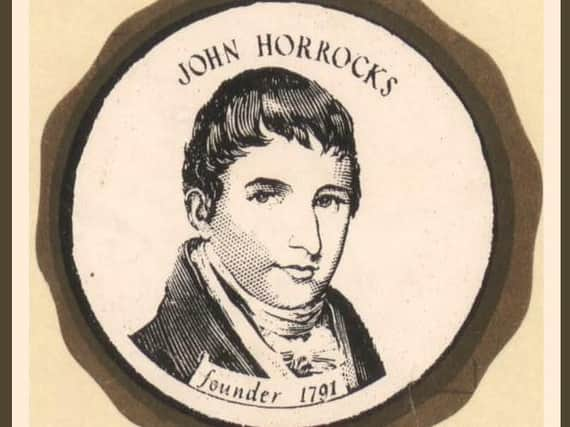Tycoon who changed Lancashire forever


John Horrocks was born in Edgworth, near Bolton, on March 27, 1768. His family operated a quarry in the area, which was where John first began spinning cotton, selling the finished yarn in Preston. One of the earliest items in the Horrockses archive is a map showing the land owned by the family at Bradshaw, which clearly identifies a stone mill owned by John Horrocks senior alongside a cotton mill owned by John Horrocks junior. John jr eventually moved his business to Preston, initially working from a building at Turks’ Head Court before opening his first factory in 1791. This was located at Dale Street and became known as the Yellow Factory because of its faded whitewash. Shortly after, he obtained a monopoly of the manufacture of cottons and muslins for the Indian market from the British East India Company.John was one of the leading figures in Lancashire’s textile revolution and the company he founded expanded at a remarkable rate. Within 10 years he owned seven large mills and, in 1816, the company, which became Horrockses, Miller and Company, also employed 7,000 handloom weavers working at home. In 1801 Horrocks built himself a mansion in Lower Penwortham, known as Penwortham Lodge or Hall ,but unfortunately he did not live much longer to see the great success his company would become. During the same period he served on the borough council and as Tory MP for Preston. He died in London in 1804 of brain fever – reportedly resulting from overwork – and is buried at St Mary’s Church in Penwortham. Horrockses came to dominate the centre of Preston as, during the 19th century, additional factories were built on the site of the Yellow Factory, which collectively became known as the Yard Works. To mark 100 years of the company, and as a sign of its continuing success progress, the massive Centenary Mill was built on New Hall in Preston in 1891. With the later decline of the textile industry in Lancashire, the Mill became a warehousing and distribution centre and, by the 1980s, was disused. It has now been converted into apartments.Probably the most interesting material in the company’s archive from this period relates to international trade. Horrockses Miller and Company had a number of agents across the world, in countries as diverse as Portugal, Mexico, India and China, and made arrangements not only to sell their cotton in these markets, but also to ship other goods for sale. This trade included the purchase of opium in India to be sold in China, where tea and silk would be bought and brought back for sale in England. Much of the business correspondence dates from a time of international conflict, and there are references in the letters to the Opium Wars, rebellions in India and Portugal and the Mexican-American war. The company was also involved in conflict much closer to home. The longest industrial dispute in Preston’s history took place between October 1853 and May 1854, and became known as the Preston Lock Out. During the 1840s cotton workers throughout Lancashire had suffered a 10 to 20 per cent cut in their wages and they began to strike in efforts to have it reinstated. In retaliation, the cotton masters, including Horrockses Miller and Company, locked the workers out of the mills denying them a living. As well as direct action, public opinion seems to have been central to the dispute, and the archive includes a collection of bill posters written from the viewpoint of both the striking workers and their employers. In happier times the company would often take the opportunity to publicise their goods at Preston’s Guild celebrations, providing floats which would appear in the trade procession and building decorative Guild arches from cotton bales.Heritage seems to have been important to the company, which perhaps explains why we are fortunate to have such an extensive collection of surviving records. Advertising would celebrate the longevity of the firm and the quality of the goods produced. As the international marketplace for textiles became far more competitive in the 20th century, Horrockses worked hard to stay on top, most notably perhaps with the launch of Horrockses Fashions in the late 1940s. It is this part of the business which is perhaps the most widely remembered today, as the company began using their own cottons to produce off the peg dresses which would prove to be extremely fashionable. Designs were commissioned from notable artists and designers, including Pat Albeck, Graham Sutherland and Alastair Morton, and the Queen famously wore Horrockses dresses on her first Commonwealth Tour. While the company itself was eventually bought out by Carrington Viyella, the Horrockses name still lives on in ranges of homewares and dresses inspired by the original designs of the 1940s and 50s. By far the most unusual item in the collection is from a file of trademarks applications. Included is a design for a registered trademark described as ‘An alligator stands on its hind legs juggling five young alligators whilst a Turk stands by’(pictured inset)! As well as oddities such as this, the archive contains wages books from the late 18th century, pattern books, photographs, plans and much, much more – a record of one man’s and one company’s contribution to Lancashire’s story l In celebration of the 250th birthday of John Horrocks Lancashire Archives will be holding an event on Saturday (March 24) with exhibitions, talks, film and sound archives. Tickets are £5 and places should be booked in advance by contacting 01772 533039 or record.office@lancashire.gov.uk and payment made on the day.